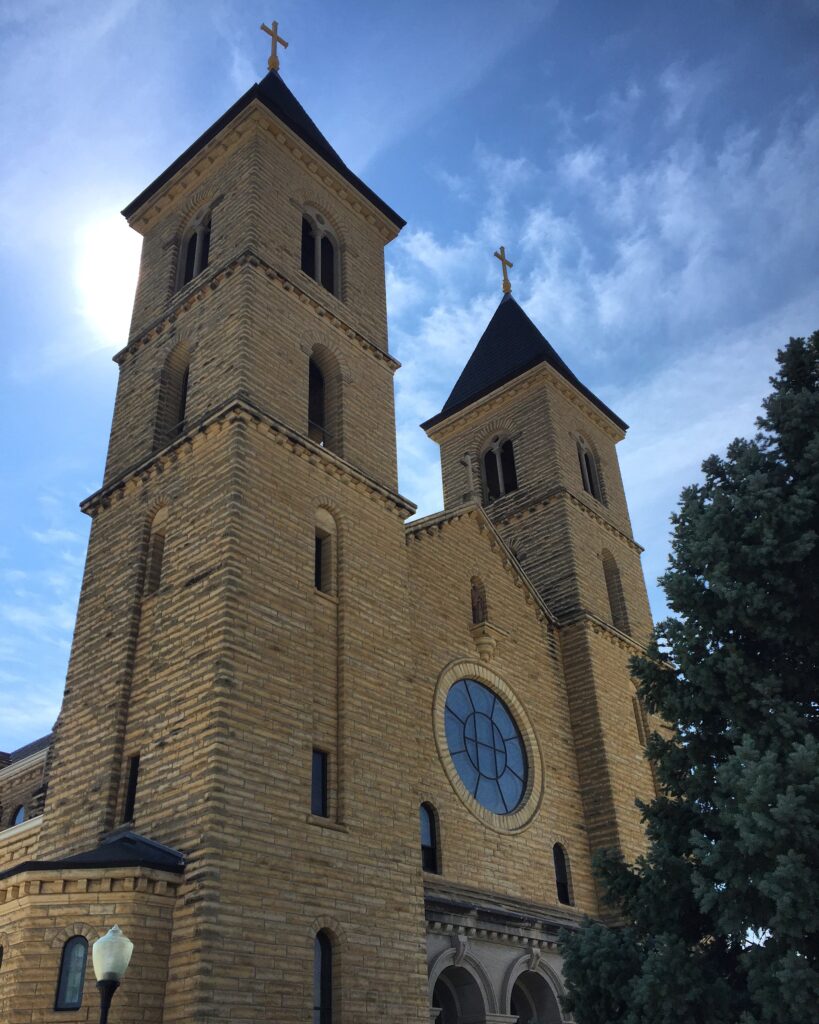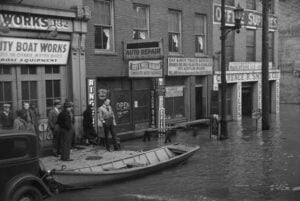The “cathedral” in rural Kansas

The facade of the Cathedral of the Plains in Victoria, Kansas. Photo by Devin Walk.
If you’ve driven west on I-70 between Topeka and Denver, you’ve probably seen two church towers off in the distance, about 10 miles east of Hays in the tiny town of Victoria, Kansas. The Basilica of St. Fidelis, a Roman Catholic church nicknamed the Cathedral of the Plains by William Jennings Bryan in 1912, paints a striking figure against the remote prairies of central Kansas.
The Romanesque church, a sight more likely to be seen in Western Europe or America’s urban areas, was selected by The Kansas Sampler Guidebook as being one of the 8 wonders of Kansas.
Despite its moniker, St. Fidelis is not technically a cathedral, as it does not serve as the seat of a bishop. In 2014, Pope Francis declared it a minor basilica, making it the only one of its kind in Kansas. The church’s seating capacity of 1,100, at the time of its dedication in 1911, made it the largest church west of the Mississippi.
The Cathedral of the Plains’ appearance
The Cathedral of the Plains is an architectural marvel. It stretches 220 feet in length, with a width of 110 feet at the transepts and 75 feet at the nave. The ceiling towers 44 feet above the ground, while the twin towers rise 141 feet above the rural Kansas town. The exterior complements the local landscape. It was constructed of large native limestone blocks weighing between 50 to 100 pounds each.
The interior is also striking. Inside, granite columns imported from Vermont support the arched ceiling. The Stations of the Cross were carved in Austria and painted in a variety of naturalistic colors. The exceptional high altar depicts the martyrdom of St. Fidelis.
The church’s 48 stained-glass windows are considered among the most outstanding of their type in the United States. The stained glass windows were imported from the Munich Studios in Chicago where they were made by German artisans that fled Germany because of World War I. An artisan from the company installed them in 1916 at a cost of $3,700. Today, they’re valued at more than $1 million.
The detailed windows depict the lives of Jesus and Mary, the angel Gabriel, the Holy Spirit, God the Father, and more. The prominent rose window depicts St. Cecilia, the patroness of music playing a piano or harpsichord-type instrument.

The parishioners
In 1876, a group of immigrants from the Russian Steppes known as Volga-Germans, immigrated to Victoria, Kansas. They fled mandatory service in the Czar’s army enforced by a Russia that persecuted Catholics. The Volga-Germans had moved to Russia at the behest of Russian Empress, Catherine the Great. Catherine was German-born and offered the German Catholics free farmland and refuge from the Protestant-controlled German states. However, 100 years later, the Russians reneged on their agreement. The Bolsheviks shipped off the remaining Volga-Germans to Siberia during WWII.
Construction
The Catholic community in Victoria went through four church buildings including a modest side room of a local house. The final twin-towered soaring church was finished in 1911 only taking four years to construct.
The parish enlisted John T. Comes, a prominent cathedral architect in Pittsburgh, PA to design the church. Parishioners helped construct the massive structure. The men of the community quarried and hauled up to 80 wagonloads of local limestone from 7 miles away. The parishioners’ tool marks can still be seen on the exterior limestone blocks.
“[You] have to remember there weren’t any machines to use at that time. All this work was done by human labor, and they had a couple horses and that’s all that’s all they used.” – Ivan Werner, a parishioner and tour guide of St. Fidelis told KMUW Witchita.
They imported Bedford stone from Indiana, which they used to decorate the church’s doorways and entrance.

The Cathedral of the Plains today
As a basilica, the sanctuary now displays a tintinnabulum (bell) and an ombrellino (umbrella) as symbols of the pope. The official name is now The Basilica of St. Fidelis, but most people still call it the Cathedral of the Plains.
The church gets a standing-room-only crowd when there are special services and concerts. The building’s high ceiling and stonework create the ideal acoustic platform for choir and organ performances.
Each year the basilica welcomes over 16,000 tourists. The church located off Exit 168, is open during daylight hours for visitors.
It’s worth a visit for those wishing to break up the monotony of a trip across the Great Plains. Especially if you visit mid-day when the sun shines through the stained glass windows illuminating the church in an array of brilliant colors.
Sources:
https://sites.ualberta.ca/~german/AlbertaHistory/Volgagermans.htm
https://www.ncregister.com/features/prairie-style-the-cathedral-of-the-plains-rises-above-flat-lands
https://www.stfidelischurch.com/st-fidelis-victoria-kansas
https://www.kmuw.org/the-range/2020-12-11/photos-cathedral-of-the-plains-worth-a-detour-out-west
http://www.kansastravel.org/cathedralofheplains.htm
Other Kansas stories:
Kansas’ hysteria over women’s STDs



